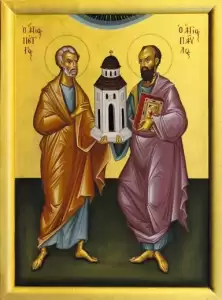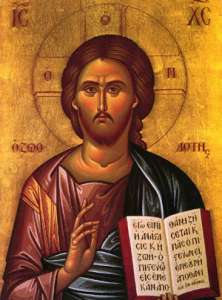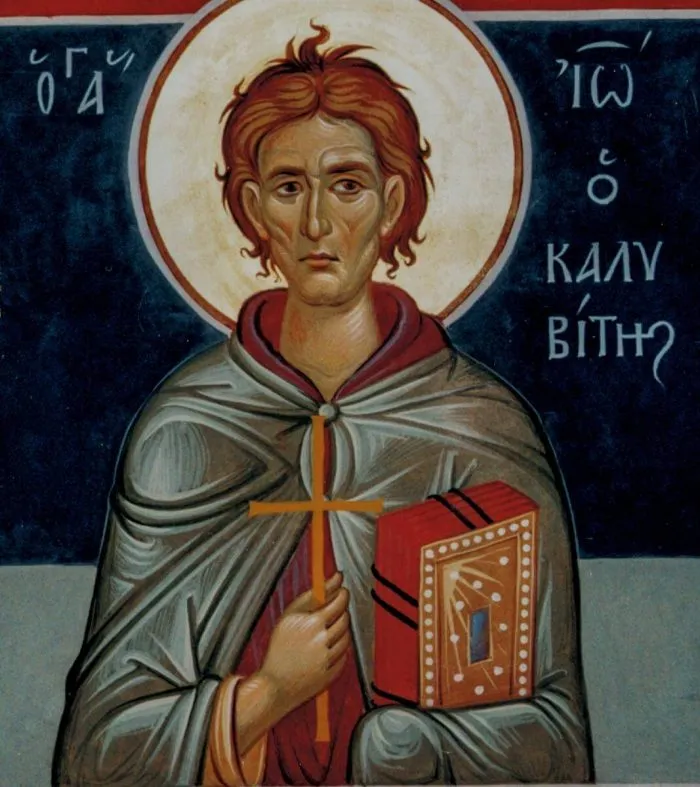Warning: Undefined array key "margin_above" in /home/stscahvallejo/public_html/wp-content/plugins/ultimate-social-media-icons/libs/controllers/sfsiocns_OnPosts.php on line 652
Warning: Undefined array key "margin_below" in /home/stscahvallejo/public_html/wp-content/plugins/ultimate-social-media-icons/libs/controllers/sfsiocns_OnPosts.php on line 653
September 2024
“Have you fallen seriously ill? This brings you the crown of martyrdom [through thanksgiving]. Nothing is holier than that tongue which gives thanks to God in evil circumstances; truly in no respect does it fall short of that of Martyrs; both alike are crowned, both the former and the latter”
St. John Chrysostom
 Epistle Reading
Epistle Reading
The reading is from St. Paul's Letter to the Colossians 3:4-11
Brethren, when Christ who is our life appears, then you also will appear with him in glory. Put to death therefore what is earthly in you: fornication, impurity, passion, evil desire, and covetousness, which is idolatry. On account of these the wrath of God is coming upon the sons of disobedience. In these you once walked, when you lived in them. But now put them all away: anger, wrath, malice, slander, and foul talk from your mouth. Do not lie to one another, seeing that you have put off the old nature with its practices and have put on the new nature, which is being renewed in knowledge after the image of its creator. Here there cannot be Greek and Jew, circumcised and uncircumcised, barbarian, Scythian, slave, free man, but Christ is all, and in all.
Idolatry
St. Paul teaches that
Questions:
- A good way to remember your baptism is to celebrate the anniversary of your baptismal date like a birthday every year because you were born from above on that day!
- What are some ways we can remember to live according to the new nature we have received?
 Gospel Reading
Gospel Reading
The Gospel According to Luke 17:12-19
At that time, as Jesus entered a village, he was met by ten lepers, who stood at a distance and lifted up their voices and said: "Jesus, Master, have mercy on us." When he saw them he said to them, "Go and show yourselves to the priests." And as they went they were cleansed. Then one of them, when he saw that he was healed, turned back, praising God with a loud voice; and he fell on his face at Jesus's feet, giving him thanks. Now he was a Samaritan. Then said Jesus: "Were not ten cleansed? Where are the nine? Was no one found to return and give praise to God except this foreigner?" And he said to him: "Rise and go your way; your faith has made you well."
An attitude of gratitude
St. Paul exhorts us to "pray without ceasing" and as Orthodox Christians we respond to this challenge by reciting the Jesus Prayer continually. Yet giving thanks to God is also something we ought to do without ceasing because the Lord is constantly providing for us. St. Basil the Great offers a beautiful way on how we can maintain and attitude of gratitude and give thanks to God continually.
”When you sit down to eat‚ pray. When you eat bread‚ do so thanking Him for being so generous to you. If you drink wine‚ be mindful of Him who has given it to you for your pleasure and as a relief in sickness. When you dress‚ thank Him for His kindness in providing you with clothes. When you look at the sky and the beauty of the stars‚ throw yourself at God’s feet and adore Him who in His wisdom has arranged things in this way. Similarly‚ when the sun goes down and when it rises‚ when you are asleep or awake‚ give thanks to God‚ who created and arranged all things for your benefit‚ to have you know‚ love and praise their Creator.”
Our worship in the Divine Liturgy is centered on the act of thanksgiving. In fact, the very word for Eucharist in Greek means thanksgiving (Efcharisto). Our worship on Sunday is one, long, heart-felt song of giving thanks to God for all he has done for us and especially for the forgiviness of sin, grace and sanctification we receive through Holy Communion.
Questions:
- What are some things you are thankful for?
- What prevents us from remembering to give thanks to God?
 St. John the Hut-Dweller
St. John the Hut-Dweller
Saint John the Hut-Dweller was the son of rich and illustrious parents, and was born in Constantinople in the early fifth century. He received a fine education, and he mastered rhetoric and philosophy by the age of twelve. He also loved to read spiritual books. Perceiving the vanity of worldly life, he chose the path that was narrow and extremely difficult. Filled with longing to enter a monastery, he confided his intention to a passing monk. John made him promise to come back for him when he returned from his pilgrimage to Jerusalem, and take him to his monastery.
He asked his parents for a Gospel so that he might study the words of Christ. John’s parents hired a calligrapher to copy the text, and had the volume bound in a golden cover studded with gems. John read the Gospel constantly, delighting in the Savior’s words.
The monk kept his promise to come back for John, and they went secretly to Bithynia. At the monastery of the “Unsleeping” (Akoimitoi), he received monastic tonsure. The young monk began his ascetical labors with zeal, astonishing the brethren with his unceasing prayer, humble obedience, strict abstinence, and perseverance at work.
After six years, he began to undergo temptations. He remembered his parents, how much they loved him, and what sorrow he caused them. He regretted leaving them, and was filled with a burning desire to see them again.
Saint John explained his situation to the Igumen Saint Marcellus (December 29) and he asked to be released from the monastery. He begged the Igumen for his blessing and prayers to return home. He bid farewell to the brethren, hoping that by their prayers and with the help of God, he would both see his parents and overcome the snares of the devil. The Igumen then blessed him for his journey.
Saint John returned to Constantinople, not to resume his former life of luxury, but dressed as a beggar, and unknown to anyone. He settled in a corner by the gates of his parents’ home. His father noticed the “pauper,” and began to send him food from his table, for the sake of Christ. John lived in a small hut for three years, oppressed and insulted by the servants, enduring cold and frost, unceasingly conversing with the Lord and the holy angels.
Before his death, the Lord appeared to the monk in a vision, revealing that the end of his sorrows was approaching, and that in three days he would be taken into the Heavenly Kingdom. Therefore, he asked the steward to give his mother a message to come to him, for he had something to say to her.
At first, she did not wish to go, but she was curious to know what this beggar had to say to her. Then he sent her another message, saying that he would die in three days. John thanked her for the charity he had received, and told her that God would reward her for it. He then made her promise to bury him beneath his hut, dressed in his rags. Only then did the saint give her his Gospel, which he always carried with him, saying, “May this console you in this life, and guide you to the next life.”
She showed the Gospel to her husband, saying that it was similar to the one they had given their son. He realized that it was, in fact, the very Gospel they had commissioned for John. They went back to the gates, intending to ask the pauper where he got the Gospel, and if he knew anything about their son. Unable to restrain himself any longer, he admitted that he was their child. With tears of joy they embraced him, weeping because he had endured privation for so long at the very gates of his parental home.
The saint died in the mid-fifth century, when he was not quite twenty-five years old. On the place of his burial the parents built a church, and beside it a hostel for strangers. When they died, they were buried in the church they had built.
In the twelfth century the head of the saint was taken by Crusaders to Besançon (in France), and other relics of the saint were taken to Rome.
What is a Stylite?
The word stylite is from the Greek word stilos meaning a pillar. The Stylites are a group of ascetic saints who spent their lives in prayer and fasting on the top of high columns, pillars or rock formations. They would live a life of silence and continual devotion to God and also preach from the top of the pillar to the people who came seeking spiritual solace. The earliest known stylite is Simeon the Elder who climbed a pillar in Syria in the year 423 AD and remained there until his death 37 years later.
St. Simeon had a continuous series of followers, particularly in Syria and Palestine. St. Daniel the Stylite may have been the first of these, for he had been a disciple of Simeon and began his rigorous way of life shortly after his master died. Daniel was a Syrian by birth but he established himself near Constantinople, where he was visited by both the Emperor Leo and the Emperor Zeno. Simeon the Younger, like his namesake, lived near Antioch; he died in 596, and had for a contemporary a hardly less famous Stylite, Saint Alypius, whose pillar had been erected near Hadrianopolis in Paphlagonia. After standing upright for 53 years, Alypius found his feet no longer able to support him, but instead of descending from his pillar lay down on his side and spent the remaining fourteen years of his life in that position.
In recent centuries this form of monastic asceticism has become virtually extinct. However, in modern-day Georgia, Maxime Qavtaradze, a monk of the Orthodox Church, has lived on top of Katskhi Pillar for 20 years, coming down only twice a week. This pillar is a natural rock formation jutting upward from the ground to a height of approximately one hundred and forty feet. Evidence of use by stylites as late as the 10th century has been found on the top of the rock. With the aid of local villagers and the National Agency for Cultural Heritage Preservation of Georgia, Monk Maxime restored the 1,200-year-old monastic chapel at the top of the rock.
Below is a trailer for a short film about Monk Maxime and the Katskhi Pillar.
Thank you for participating in SOFIA! If you've subscribed to our newsletter, look for an email notification next week when a new lesson page is posted. See you Sunday!

 Monthly family catechism and spiritual devotion for the Orthodox home
Monthly family catechism and spiritual devotion for the Orthodox home